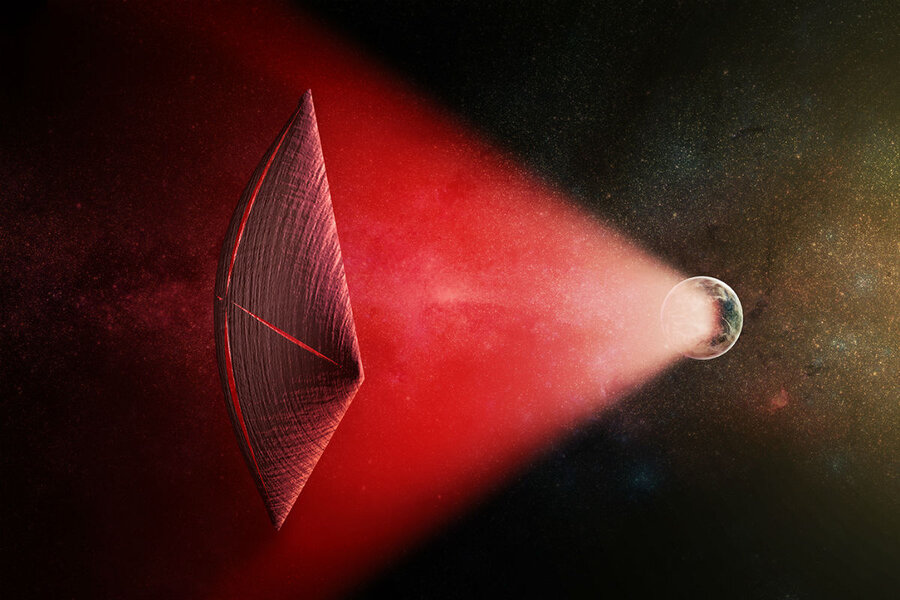Are distant radio bursts in space signs of alien sailors?
Loading...
Fast Radio Bursts. They come from galaxies far, far away, but scientists have no idea what they are.
FRBs have mystified scientists ever since they burst onto the astronomical scene in 2007. Since then, large radio telescopes have captured fewer than two dozen of the enigmatic flickers, far brighter than most known objects. Now, a pair of Harvard theorists have a wild idea: planet sized beacons that would dwarf the Death Star, and maybe even Starkiller Base.
Lasting mere thousandths of a second, the radio pulses are far too bright to match what we know about other sources that emit energy in bursts, such as the spinning neutron stars known as pulsars.
"There is no known astronomical object that generates radio bursts at such a high brightness, which is tens of billions of times brighter than the known population of pulsars, for example," co-author of the paper Avi Loeb of the Harvard-Smithsonian Center for Astrophysics told Gizmodo.
Most experts assume their origin must be some unknown class of celestial object, perhaps an exotic type of neutron star, yet a consensus as to what that class might be has yet emerge, thanks in part to a data-bottleneck, with only 17 observed events on which to base the models.
“I am not exaggerating when I say there are more models for what FRBs could be than there are FRBs,” Cornell University astronomer Shami Chatterjee told The Washington Post in January.
All scientists know is that they’re bright, they come from far away galaxies, and in at least one case they can repeat (which eliminates theories that attribute them to cataclysmic source-destroying events).
"Fast radio bursts are exceedingly bright given their short duration and origin at great distances, and we haven't identified a possible natural source with any confidence," said Dr. Loeb in a press release. "An artificial origin is worth contemplating and checking."
Enter Loeb and Manasvi Lingam’s new model. Purely a work of theory, they consider what it would take to generate such a burst artificially, what the radio beams’ observed characteristics would imply about the machine that created them, and why anyone would want to take on such a project.
Assuming that the device is solar powered and water-cooled (since starlight and water seem to be abundant resources in many star systems), they calculate that the radius would have to be about twice as large as Earth’s. The “beam emitter is an object akin to a planet; more precisely, it lies fairly close to the boundary between super-Earths and mini-Neptunes,” they write in the preprint paper, which has been accepted for publication in Astrophysical Journal Letters.
This size supports their hypothesis, they say, since a planet-scale engineering project is more feasible than say a star-scale undertaking. More compelling is that they arrived at this estimate by two independent calculations: the area of the solar panel required to gather the required energy from a sun-like star, and the amount of water needed to keep the emitter from overheating.
“These ‘coincidences’ lend some credence to the possibility that FRB’s might be artificial in origin,” they write.
As for why anyone would build a device that eats up South Korea’s annual energy consumption each second, they consider the possibility that a civilization may wish to call for help or advertise its advanced technology but conclude that these “beacon” theories rely on human thinking and are untestable.
Rather, they suggest the beams could be powering light sails, large sheets that harness the power of light waves to pull a spacecraft much like canvas sails pull a boat. The fact that the frequency of the beams turns out to be just right to push a light sail represents another eyebrow-raising “coincidence.”
The duo calculated that the sail and its cargo would both weigh around a million tons, as much as 10 aircraft carriers, which would make it hundreds of feet in length. This giant ship would be too big to be much use for quick jaunts to the moon, yet too small for the generational “world” ships needed to travel between stars, “instead, it would be more likely to operate over interplanetary distances,” they write.
What’s more, future observations could shed more light on the theory. A beam pushing a spacecraft could look different from other sources, because the ship would cast a moving shadow detectable in the burst itself. Such a signal could even reveal hints of the sail’s shape, they write.
Yet that future is a long way off. “It’s a delightful thought experiment,” said Matthew Bailes, an astrophysicist at the Swinburne University of Technology in Melbourne who was involved with the identification of the first FRB. But, he told The Washington Post, the new hypotheses represent an “incredible long shot.”
But that long shot would have been even longer not so long ago. Astronomers now understand that Earth-sized, rocky planets may be quite common, and an “alien megastructure” has been proposed to explain the mysterious flickering pattern of a dimming star. Even light sails, once an element of Arthur C. Clarke’s science fiction, could be the technology of choice for NASA’s upcoming asteroid surveying mission.
Still, the Harvard physicists aren’t placing any bets yet. They hope initiatives such as Breakthrough Listen will direct their efforts toward observing future FRB emissions from the repeating FRB 121102, and letting the results be a beacon for theorists.
“Deciding what’s likely ahead of time limits the possibilities,” Loeb told The Washington Post. “It’s worth putting ideas out there and letting the data be the judge.”








